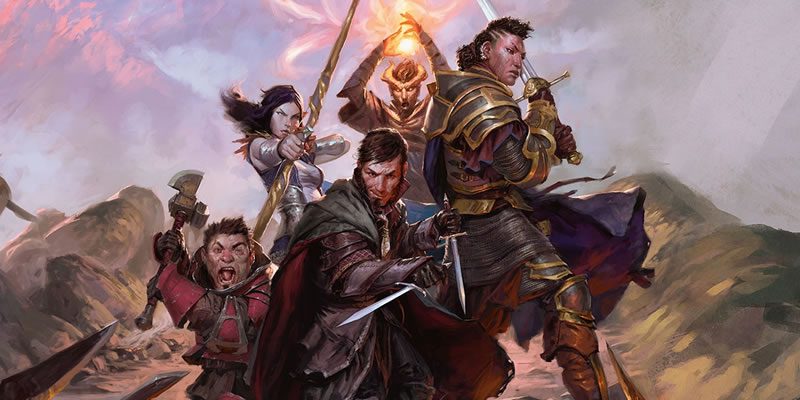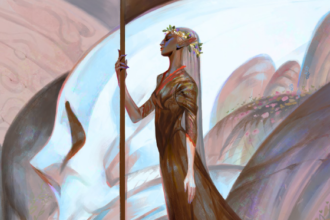Unearthed Arcana: Three Subclasses Breakdown

We’re off to the races for 2018 with a new Unearthed Arcana, this one offering one subclass each for druids, fighters, and wizards. It… feels kind of weird to even be commenting on UA subclasses with XGTE still so fresh off the presses, but I salute their commitment. Let’s see if I say the same after I read the subclasses.
The Circle of Spores
Decay and blight themes are one of the great inevitabilities of druid content, so sure, let’s do this. What I don’t get is the third paragraph of the flavor text here, which suggests both that they’re okay with undeath, but not with spreading or long-lasting undeath. Other than, arguably, revenants and some ghosts, there are no kinds of undead in D&D that come to a natural end (“natural” here meaning “other than getting their asses kicked by adventurers”). Let’s see if the features shed any light on this paradox. Let me also say that there is nowhere in extant D&D cosmology that undeath is the key to creating new life, so there’s just no support for this subclass’s core assertion.
- Their Circle Spells are mostly necromancy, including that most necromantic of all necromancy spells, animate dead. But spare a moment gentle repose, the precise opposite of their subclass concept… well, there just aren’t that many necro spells to even offer. Also you pick up chill touch.
- Halo of Spores is weird, in that it’s fixed, auto-hit damage against one nearby opponent, and that you spend your reaction on your own turn to use it. Sure, the druid action economy doesn’t care much about reactions, but it also doesn’t care much about bonus actions. I guess it’s overall easier to deny reactions than bonus actions? Anyway. Very much not a fan.
- Also, for later discussion – this is functionally a very strong single-target damage kicker.
- Symbiotic Entity gives Spore-bros a different Wild Shape effect. It gives them temporary hit points to be on par with melee brutes, boosts your melee weapon damage (since you don’t get Extra Attack, give some thought to two-weapon fighting I guess), and doubles the damage output of your Halo of Spores. Because of its duration works, you can never stack this with Wild Shaping, not that you have combat-friendly forms anyway. Because this retasks the Wild Shape feature, it takes an action to use, which is kinda steep for what it accomplishes.
- This piles on the damage kick. With melee weapons, you’re looking at, let’s say, main hand d6 + Dex + d6, off-hand d6 + d6, plus a can’t-miss 6, 12, 18, or 24 poison damage. This is a real strange combat turn, though.
- Fungal Infestation is a hot mess of a feature. I’ve talked in the past about the problems of last-hit or on-kill effects, right? This thing where your teammates might accidentally stop your cool feature from working because they attacked something instead of passing their turn and waiting for you to do it? Well, Fungal Infestation has all of those problems and then a much worse one: it only triggers if the creature dies from your Halo of Spores damage. Congratulations, you can kill-steal from yourself, Spore-bro. I mean, it’s bad enough that it only works on humanoids. Your exact order of operations in your turn matters. Precisely guessing how many hit points your enemy target has left matters. On the rare cases that you succeed, you get a 1 hit point creature. Just… no. Unless your DM practices hit point transparency, which is far from common.
- Or, and I honestly don’t know if this is as-intended, you ask your melee teammates very nicely to only strike for nonlethal damage – i.e., knocking humanoid enemies to 0 hit points but not killing them, so you can Halo them as a reaction on your next turn. I mean, it sure increases the likelihood of this working. Still kind of needlessly complicated.
- Spreading Spores lets you turn your spores into a 10-ft-cube AoE that still deals your Halo damage. This is a huge improvement, as it shifts Halo’s action economy to your bonus action, it’s an AoE with no save, and it doesn’t disable any part of Symbiotic Entity.
- The duration here is a little weird. It turns off your Halo, right? From that point on, your two options are to let its 1-minute duration run out, at which point your Halo comes back to you, or to use this feature again. What you can’t seemingly do is just draw the spores back to you and start using your Halo again normally.
- Fungal Body is delicately tuned to send me into a frothing rage. Immunity to frightened, blinded, deafened, poisoned, and critical hit extra damage. Seriously? Frickin’… seriously? Four immunities and ignoring critical damage? No, guys. Really, really no. My even, it can’t.
So, I don’t want to overstate this, but I think this subclass is a mess from top to bottom. Its theme is going along fine until it gets mangled with a cosmology malfunction. Reactions that have no trigger beyond “when you feel like it, on your own turn” are nonsense. That’s just… not a reaction! Features that require precise guessing of enemy hit points, or nonlethal damage, to work… Well, that’s weird and pushes the theme into “when you murder helpless people instead of taking them prisoner.” Is that really what we’re looking for here? It wants to be a melee weapon-wielding druid, but handles that weirdly too. And then it grants a huge range of immunities so that you passively break a lot of encounters. Spore druids: not even once.
Brute Fighter
The flavor text for this could not be any more devoid of content. It’s a fighting fighter that fights real good, except they spell it fietin’ fiter that fytes reel gud, because thinking is for classes and subclasses with an actual theme. So I guess I’m starting from a place of contempt, which is something I really try not to do, but here we are.
- Brute Force adds a scaling die to your weapon damage with every attack. Because it’s added to each attack, this favors two-weapon fighting. This is a huge sustained damage boost, as a tradeoff for the burst damage of the Battle Master and the Champion.
- Brutish Durability adds a d6 to all of your saves, including an increased chance to stabilize and heal when rolling death saves. You can reasonably think of this as a passive +3 to all saves, even ones you’re already proficient in, and wow, that sounds super broken when you put it like that.
- Additional Fighting Style is an existing page in the Champion playbook. It’s fine.
- Devastating Critical adds your fighter level to your critical damage. This too favors two-weapon fighting. It’s pretty ridiculous.
- Survivor is another page from the Champion playbook.
The problem here is that the fighter – alone of all classes – is written without any significant flavor. The three Player’s Handbook subclasses are just playstyles; they don’t say anything about your role in the setting. Champion fighters aren’t inherently champions of anything – neither lords nor arenas. Now, in isolation, that’s fine; the fighter has always been the class where you had to develop your own meaning. (I say this while still on hiatus from saying exactly the same thing in the History of the Fighter series.) The problem, then, is that this is the simple-straightforward-smashy playstyle, that is in every way identical to the Champion. Compare:
XXXXXX are simple warriors who rely on mighty attacks and their own durability to overcome their enemies. Some brutes combine this physical might with tactical cunning. Others just hit things until those things stop hitting back.
And
The archetypal XXXXXX focuses on the development of raw physical power honed to deadly perfection. Those who model themselves on this archetype combine rigorous training with physical excellence to deal devastating blows.
In a blind taste test, 10 out of 10 readers couldn’t tell which theme applied to the Brute and which to the Champion, and that’s, um, bad? At minimum, this is mechanics for the pure sake of mechanics, since there’s no new niche carved out here. Even the mechanics are almost as much re-used as new.
Trying to read between the lines, I take it as a push toward a radically simplified, stripped-down 5e that treats the Brute as the fighter subclass, much as D&D Basic does with the Champion. In fairness, if that’s actually what they’re noodling with, I would only want to see the other classes brought to the same place of vastly improved sustained damage.
School of Invention
The theme of the School of Invention is running in a bunch of different directions at once. The initial flavor text is fine, but the features tell one too many stories at the same time. Anyway, these guys are sort of your Mad or (Careless) Experimenter types, with unpredictable results, explosive throughput, and arcane tinkering. I’m cautiously intrigued.
- Tools of the Inventor makes sure you have proficiency in two types of tools. All things considered, go with thieves’ tools and any one other. Smith’s tools, probably, but see how your DM feels about XGTE’s drilldown on tool use first.
- Arcanomechanical Armor gives you a suit of +0 studded leather, which grants force resistance. You’re proficient in its use, which is good! It doesn’t ever improve, and if you find a better suit of magical studded leather, this feat boils down to “Yay, proficiency!” Anyway, this is… fine, maybe underwhelming, but the main 2nd-level feature is still coming up. I would be a lot more into this if it gave you some way to apply your Int bonus to AC, which would still be 100% on-theme.
- I will say that reinforced clothing with a zillion extra pockets and such is a classic part of the inventor-wizard image, and I dig that.
- Reckless Casting is the playstyle-builder of 2nd level, but I hope you like unpredictability. This lets you potentially cast spells you don’t have prepared, but you have very little control there. Heck, a good percentage of the time, you get to toss off two spells for the (action and spell slot) cost of one, and when that happens, I’m betting you just blew everything to hell.
- I… honestly don’t know how I feel about this. Part of me wants to dislike it, but I’ll be damned if it’s not so on-message for dangerous inventor-wizards. This should probably be a little more linked to a handheld device of some time, or a flux capacitor, but you can fix that in your own roleplay. I think this feature will be a disaster in all the best ways. Uh, you’re going to have a lot of weird, difficult decisions when you wind up with a spell that has no possible use in your current tactical situation, or you have no choice but to dump Concentration on something important in exchange for something unimportant.
- Alchemical Casting perversely makes Arcanomechanical Armor worse, because it requires you to be wearing and attuned to your A-M armor in order to use this feature. That means that finding a better suit of studded leather armor means either skipping it or sacrificing another major feature. Thumbs down, because it means you’re not in the loot chase for your armor type, and from 2nd level onward, you’re missing a precious attunement slot just to use subclass features.
- Okay, but about this feature’s effects: it lets you dump more of your low-level spell slots to change the damage type or deal more damage. This is not great when you receive it – you just don’t have the spell slots to burn – but it gets substantially better at high levels, when your cantrips start outweighing your 1st– and 2nd-level damage spells.
- Prodigious Inspiration lets you change a prepared spell on the fly, as a bonus action, once per short rest. This is super good for wizards, especially right at the moment when XGTE and third-party content gives a huge boost to the breadth of spells available to them.
- Controlled Chaos is a power boost to keep you using Reckless Casting even when you’re high-level and don’t need to take chances anymore… because getting to spend one 4th-level slot for even a long shot at casting two 5th-level spells, I mean, who can pass that up?
To my great surprise, I like this subclass. I’m so used to mad inventors, reckless spellcasters, and wild mages being super close to more liability than asset, both in the source fiction and in mechanics. With the School of Invention, though, I can clearly see how the mechanics support theme, while still trading risk for a huge payoff. My only issue with the class as it stands is the function and burden of Arcanomechanical Armor, as described. If that gets retooled, I think this subclass could work out.
Conclusion
I’d rate the Spore druid a serious miss – it can work at the table, but only with deep intrusion on the whole flow of play. The Brute fighter is a miss in the existing metagame – it has no theme, and its mechanics are just better than the Champion, to an utterly offensive degree. In a hypothetical alternate metagame where 5e descends back into the primordial ooze and emerges once more in a simplified form, then sure, it could work. The School of Invention looks good to me, with only one significant problem – and that problem only matters if acquiring better studded leather actually happens in your game.



